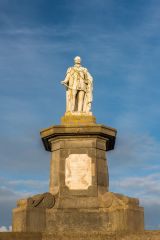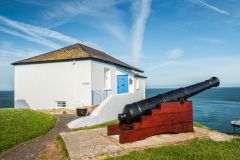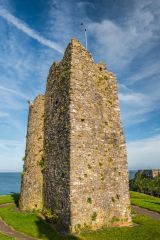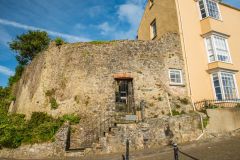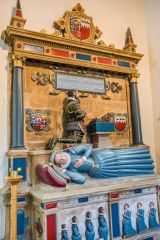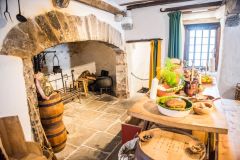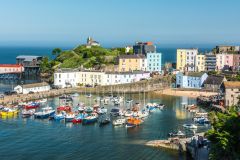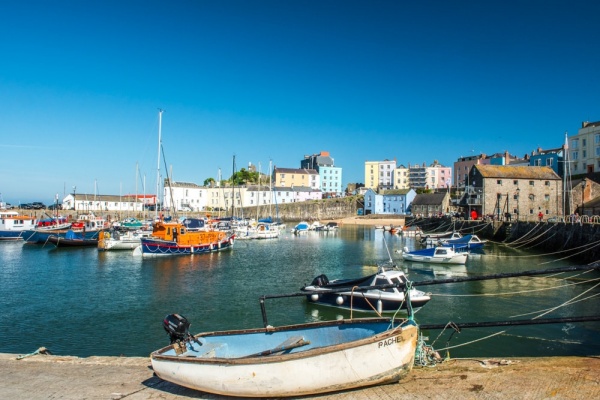
The Pembrokeshire town of Tenby is built around a picturesque harbour, bounded by cobbled lanes and pretty historic buildings. From its roots as a medieval walled town to its heyday as a Victorian seaside resort, Tenby retains a strong sense of its rich and fascinating heritage. Today Tenby draws holiday-makers to its attractive sandy beaches, but there is so much more to the historic town than sand and surf.
History
Tenby was settled as early as the 9th century, but it was really the Norman invasion of south Wales that prompted the town's growth as a major port and trading centre. Tenby was defended by a small Welsh fortification on what is now Castle Hill. There doesn't seem to have been any concerted attack on Tenby, but the fortress and town were quickly absorbed into the new Norman territory that became known as 'little England beyond Wales'.
The Earls of Pembroke rebuilt the Welsh fortification as Tenby Castle, occupying the headland overlooking the harbour and beach. The Normans encouraged large numbers of immigrants from Flanders and England, turning Tenby from a Welsh settlement into a bustling English centre of trade. The Welsh did not easily let go of Tenby and over the next few centuries the town was attacked and sacked several times. The most devastating attack came in 1260 when Llewelyn ap Gruffydd ransacked Tenby.
William de Valence, the new Norman Earl of Pembroke, knew he needed to do something to improve the town's defences so he began the imposing town walls that encircled the landward approaches. The town walls were strengthened and heightened several times over the following centuries and the defences improved by adding a wide ditch, or dry moat, outside the wall.
Tenby's walls are some of the best-preserved medieval town walls in Britain. The walls were pierced by four gates of which just one, the West Gate, remains. The West Gate is defended by a barbican tower known as the Five Arches.
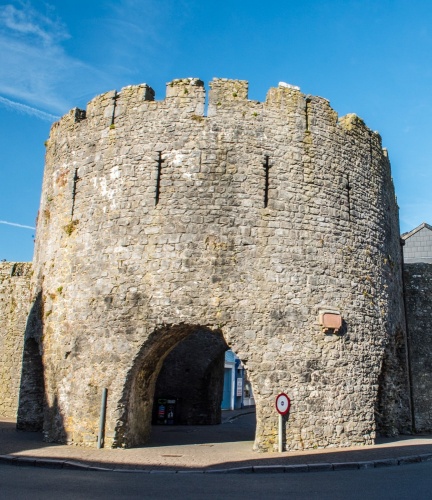
Tenby's Underground Tunnels
There is plenty to see above ground in Tenby, but one of the town's most intriguing historical remains lies hidden beneath the busy streets, for Tenby is built on a labyrinth of medieval tunnels. The network of tunnels began in the Middle Ages when Tenby was a busy market town and trading centre.
Merchants built underground cellars and tunnels to store their goods, and over time the tunnels were linked to each other, creating a network of passageways, many of them running down to the harbour where goods were loaded and unloaded.
Henry Tudor's Great Escape
Tenby's tunnels played a role in one of the most dramatic episodes in medieval history, when Henry Tudor, then aged just 14, escaped from his enemies by hiding in the tunnels and then sneaking down to the harbour to board a ship taking him to safety in Brittany.
In 1471 Henry Tudor was on the run, pursued by the soldiers of Edward I. Henry and his uncle Jasper Tudor hid in tunnels under the house of Thomas White, a wealthy merchant and Mayor of Tenby. White's house on High Street stood on the site now occupied by Boots the Chemist. The royal soldiers searched for the Tudors in vain, and when it was safe Henry was spirited away down the tunnel to the harbour where he slipped on board one of White's ships.
The ship set sail on a scheduled trading voyage to France but bad weather forced it to land in Brittany where Tudor was safe from pursuit. Fourteen years later he returned and gained the throne as Henry VII after defeating Richard III at the Battle of Bosworth.
It is a dramatic tale, but is it true?
There is no contemporary evidence of the escape, and the first written mention of it does not emerge until the late 16th century, a hundred years later. It certainly could be true; Henry Tudor was born at nearby Pembroke Castle and probably spoke at least some Welsh.
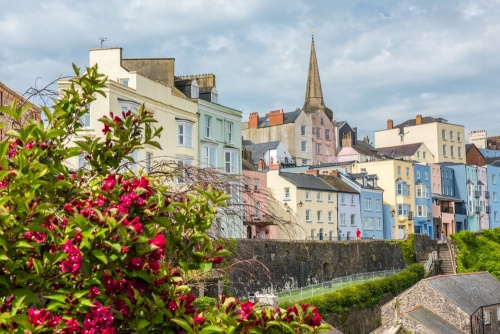
Civil War and Plague
Tenby supported Parliament at the outbreak of the Civil War. Royalist supporters captured the town in 1643, but early in the following year a Parliamentary army besieged Tenby and broke through the North Gate and forced the Royalist troops to surrender. Tenby was left in a dire state after the Civil War.
When Cromwell visited in person in 1649 he was so moved by the poverty and decay he saw around him that he gave the Mayor 10 pounds, a very large sum at the time, to help the poor. Just a year after Cromwell's visit things got much worse when an outbreak of Bubonic plague devasted the inhabitants.
The town was isolated from the outside world when traders became too afraid to enter the town walls. They left food for the Tenby residents outside the walls, and the Mayor had to pay locals to go fetch the food. As many as 500 people out of a total population of just 1,000 residents are thought to have died, many of them buried in paupers' graves in St Mary's churchyard.
From a busy medieval trading centre, Tenby turned into a ghost town, with abandoned buildings and a depleted population. It seemed the town would dwindle into insignificance.
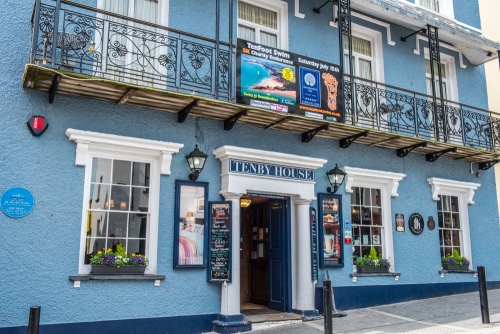
Victorian Tenby
Tenby began to recover in the late 18th century when its location made it a destination for people keen to enjoy the health-giving benefits of the seaside location. People came to be cured of disease, or if they didn't have a disease, to ensure that they didn't get one. And, to be fair, the combination of fresh air, bathing on the beach, and taking cliff-top walks, probably did help improve visitors' health.
An essential part of the Tenby visitor experience was promenading; people dressed in their finest apparel walking where they could see and be seen by other members of polite society. Walks were created linking Castle Hill to the major beaches. On the slope of Castle Hill, a bandstand was built for outdoor concerts. Later in the Victorian period, a striking monument to Prince Albert was erected on the top of Castle Hill, within the medieval castle walls.
Also within the castle walls was Tenby Museum and Art Gallery, the oldest independent museum in Wales, opened in 1878, using a restored National School that itself had been formed from the medieval castle outbuildings. Today the Museum tells the story of Tenby from its 9th-century origins to its heady days as a Victorian resort.
Terraces of fashionable houses crowded the cliff-tops around the historic medieval town, changing Tenby into a stylish destination for high society. Though many of these new houses were built for seasonal habitation the overall population of Tenby increased dramatically. Many of the new houses became hotels catering to the influx of visitors.
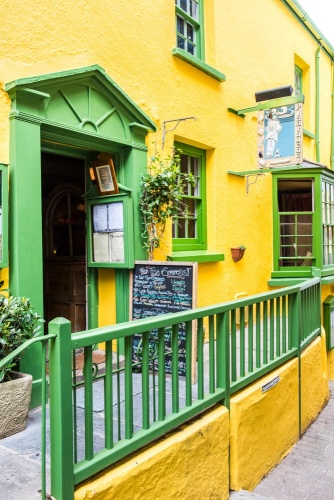
What to See
St Mary's Church
Tenby's 13th-century parish church is one of the largest in Wales. The church boasts a medieval wagon roof with carved bosses and a wealth of memorials dating to the 15th century. Among the memorials is that of Robert Recorde, a Tenby native. Recorde was a mathematician and the man credited with creating the concept of the '=' sign in mathematical calculations.
One notable memorial is that of Thomas White, the 15th century Mayor of Tenby credited with helping Henry Tudor to escape through his underground tunnels. The finest memorial, however, is that of Margaret Mercer, who died in 1610. By the entrance door are a pair of medieval effigies, the oldest dated to the 14th century.
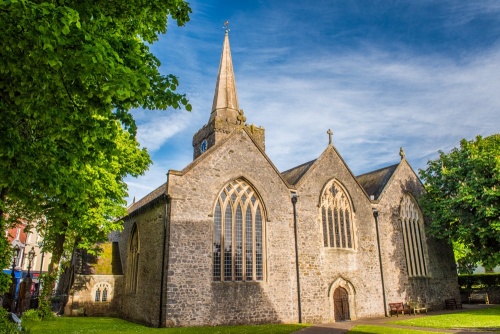
Medieval Town Walls
It is a short stroll from the church to West Gate and the Five Arches, the most impressive remaining part of Tenby's medieval town walls. The walls extend from the Five arches along South Parade and St Florence Parade to the cliffs, and up South Parade to White Lion Street in the other direction.
More on the Medieval Town Walls >>
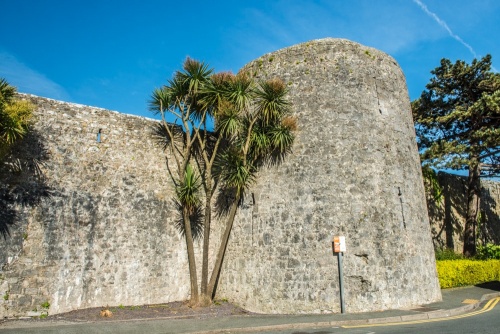
Tenby Castle
Reached by steep streets from the picturesque harbour area is Tenby Castle. At the centre of the castle enclosure is a 13th-century Watchtower and the smallest 'great tower' in Wales, inspired by the tower of Pembroke Castle. Beside the Watchtower is a monument to Prince Albert, unveiled in 1865 by Prince Arthur, eldest son of Queen Victoria and Prince Albert. Several sections of castle walls remain and small gateways, one of them leading up to the Museum and Art Gallery inside the castle walls. At the foot of Castle Hill is the Tenby Lifeboat Station. There is a public viewing gallery, usually open weekdays, and the public is invited to watch scheduled practice launches.
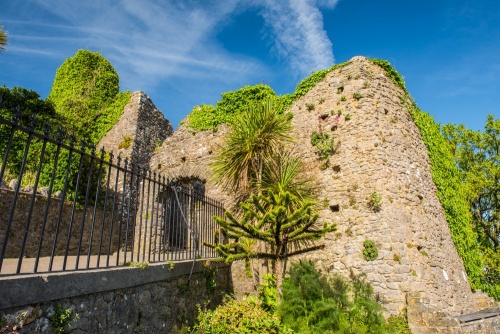
Tenby Museum & Art Gallery
The museum is probably the best place to get a good overview of Tenby's history and maritime heritage. There is a pair of galleries, one of changing exhibits and the other with permanent displays of works by artists with links to Tenby including Augustus John, who was born here. Museum highlights include civic regalia, archaeological finds, and the impressive Tenby Cannon, a nine-foot-long Tudor cannon similar to those found on the wreck of the Mary Rose.
More on the Tenby Museum & Art Gallery >>
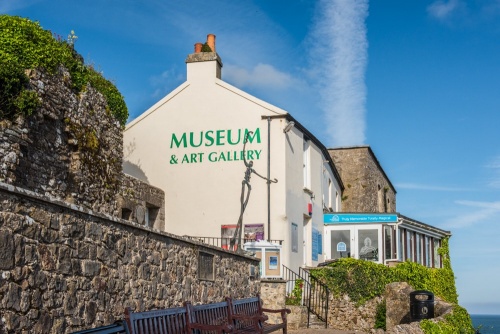
Tenby Tudor Merchant's House
Just a few steps from the harbour is a late 15th-century townhouse owned by the National Trust. It is the oldest complete house in Tenby and a reminder of the prosperity of Tenby as a medieval trading centre. The house is presented as it would have looked in the year 1500, with a shop and kitchen at ground level, a family living area on the first floor, and a bedchamber with four-poster bed on the top floor. Beside the Merchant's House is Plantagenet House, with some parts of the building dating back to the 10th century.
More on the Tudor Merchant's House >>
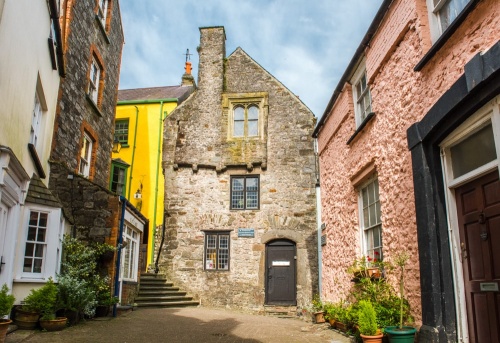
St Catherine's Island
From the museum you can get spectacular views of St Catherine's Island, which can only be reached on foot at low tide. The cliffs are riddled with caves, and atop the cliffs is a 19th-century fortress built in 1870 to counter the threat of a French invasion. The fort is open for group tours throughout the year.
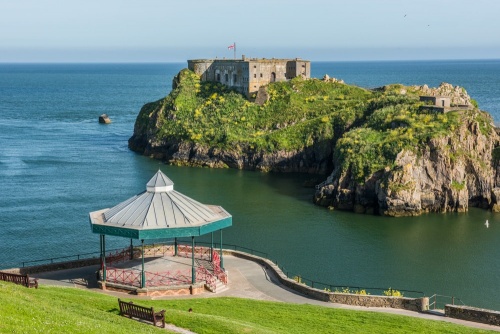
Caldey Island
Further offshore is Caldey Island, home to a modern monastery on the site of a medieval abbey. The abbey, in turn, replaced a Celtic priory established by St Pyro in the 6th century. There are two medieval churches, a 19th-century lighthouse, the remains of the medieval priory, and a Norman-era watchtower to explore. From Easter through autumn there is a regular boat service from Tenby harbour to Caldey Island.
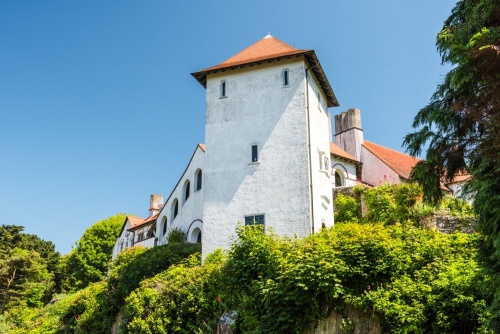
Tenby is an absolute delight to visit. The atmospheric harbour, the sandy beaches, and the picturesque cobbled lanes near the harbour all add up to an unforgettable place to explore. Our family has visited several times and we can't wait to go back.
About Tenby
Address: Tenby,
Pembrokeshire,
Wales
Attraction Type: Town
Location: On the A478, approximately 10 miles east of Pembroke. There are several paid parking areas close to the harbour and medieval town centre.
Location map
OS: SN133004
Photo Credit: David Ross and Britain Express
HERITAGE
 We've 'tagged' this attraction information to help you find related historic attractions and learn more about major time periods mentioned.
We've 'tagged' this attraction information to help you find related historic attractions and learn more about major time periods mentioned.
Find other attractions tagged with:
NEARBY HISTORIC ATTRACTIONS
Heritage Rated from 1- 5 (low to exceptional) on historic interest
Tenby Medieval Town Walls - 0 miles (Historic Building) ![]()
Tenby, St Mary's Church - 0 miles (Historic Church) ![]()
Tudor Merchant's House - 0.1 miles (Historic House) ![]()
Tenby Castle - 0.2 miles (Castle) ![]()
Tenby Museum & Art Gallery - 0.3 miles (Museum) ![]()
Penally, St Nicholas & St Teilo Church - 1.3 miles (Historic Church) ![]()
Carswell Medieval House - 2.2 miles (Historic Building) ![]()
Caldey Island Priory - 2.4 miles (Abbey) ![]()
